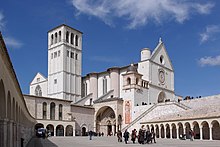| Basilica of Saint Francis of Assisi | |
|---|---|
Basilica di San Francesco d'Assisi Basilica Sancti Francisci Assisiensis | |
 | |
 | |
| 43°04′29″N 12°36′20″E / 43.07472°N 12.60556°E | |
| Location | Assisi, Italy |
| Denomination | Roman Catholic |
| Religious order | Order of Friars Minor Conventual |
| Website | sanfrancescoassisi.org |
| History | |
| Status | Papal minor basilica |
| Consecrated | 1253 |
| Architecture | |
| Architect(s) | Maestro Jacopo Tedesco[1] |
| Architectural type | Church |
| Style | Romanesque, Italian Gothic |
| Groundbreaking | 1227 |
| Specifications | |
| Length | 80 metres (260 ft) |
| Width | 50 metres (160 ft) |
| Nave width | 18 metres (59 ft) |
| Administration | |
| Division | Pontifical Legation for the Basilicas of Saint Francis and Saint Mary of the Angels in Assisi[2] |
| Diocese | Diocese of Assisi-Nocera Umbra-Gualdo Tadino |
| Official name | Assisi, the Basilica of San Francesco and Other Franciscan Sites |
| Type | Cultural |
| Criteria | i, ii, iii, iv, vi |
| Designated | 2000 (24th session) |
| Reference no. | 990 |
| Region | Europe and North America |
The Basilica of Saint Francis of Assisi (Italian: Basilica di San Francesco d'Assisi; Latin: Basilica Sancti Francisci Assisiensis) is the mother church of the Roman Catholic Order of Friars Minor Conventual in Assisi, a town in the Umbria region in central Italy, where Saint Francis was born and died. It is a papal minor basilica and one of the most important places of Christian pilgrimage in Italy. With its accompanying friary, Sacro Convento, the basilica is a distinctive landmark to those approaching Assisi. It has been a UNESCO World Heritage Site since 2000.
The basilica, which was begun in 1228, is built into the side of a hill and comprises two churches (known as the Upper Church and the Lower Church) and a crypt, where the remains of the saint are interred. The interior of the Upper Church is an important early example of the Gothic style in Italy. The Upper and Lower Churches are decorated with frescoes by numerous late medieval painters from the Roman and Tuscan schools, and include works by Cimabue, Giotto, Simone Martini, Pietro Lorenzetti, and possibly Pietro Cavallini. The range and quality of the works give the basilica a unique importance in demonstrating the outstanding development of Italian art of this period, especially if compared with the rest of Christian Europe.
- ^ Giorgio Vasari, "Vite de'più eccellenti pittori, scultori e architetti".
- ^ Pope Benedict XVI (9 November 2005). "Totius Orbis Of The Holy Father Benedict XVI for the Coordination of Pastoral Activities and Initiatives at the Basilicas of St Francis and of St Mary of the Angels in Assisi". Apostolic Letter "Motu Proprio". Holy See. Archived from the original on 9 July 2011. Retrieved 16 August 2011.